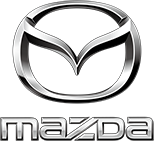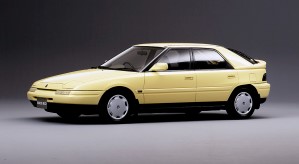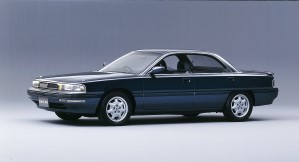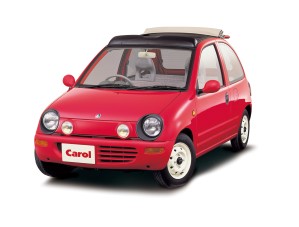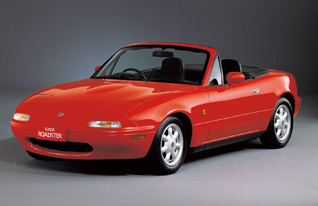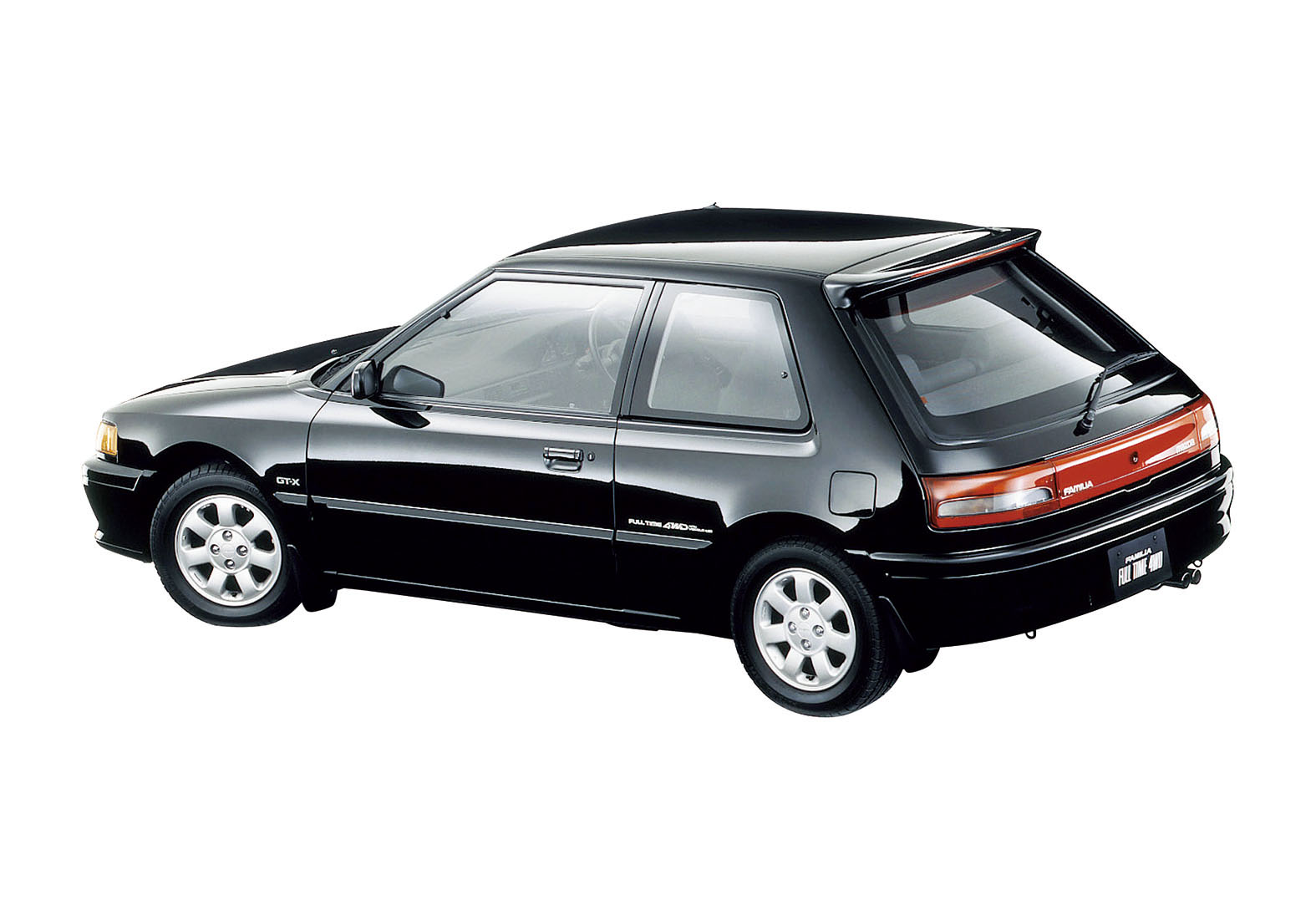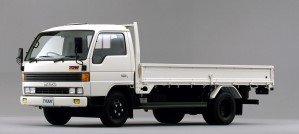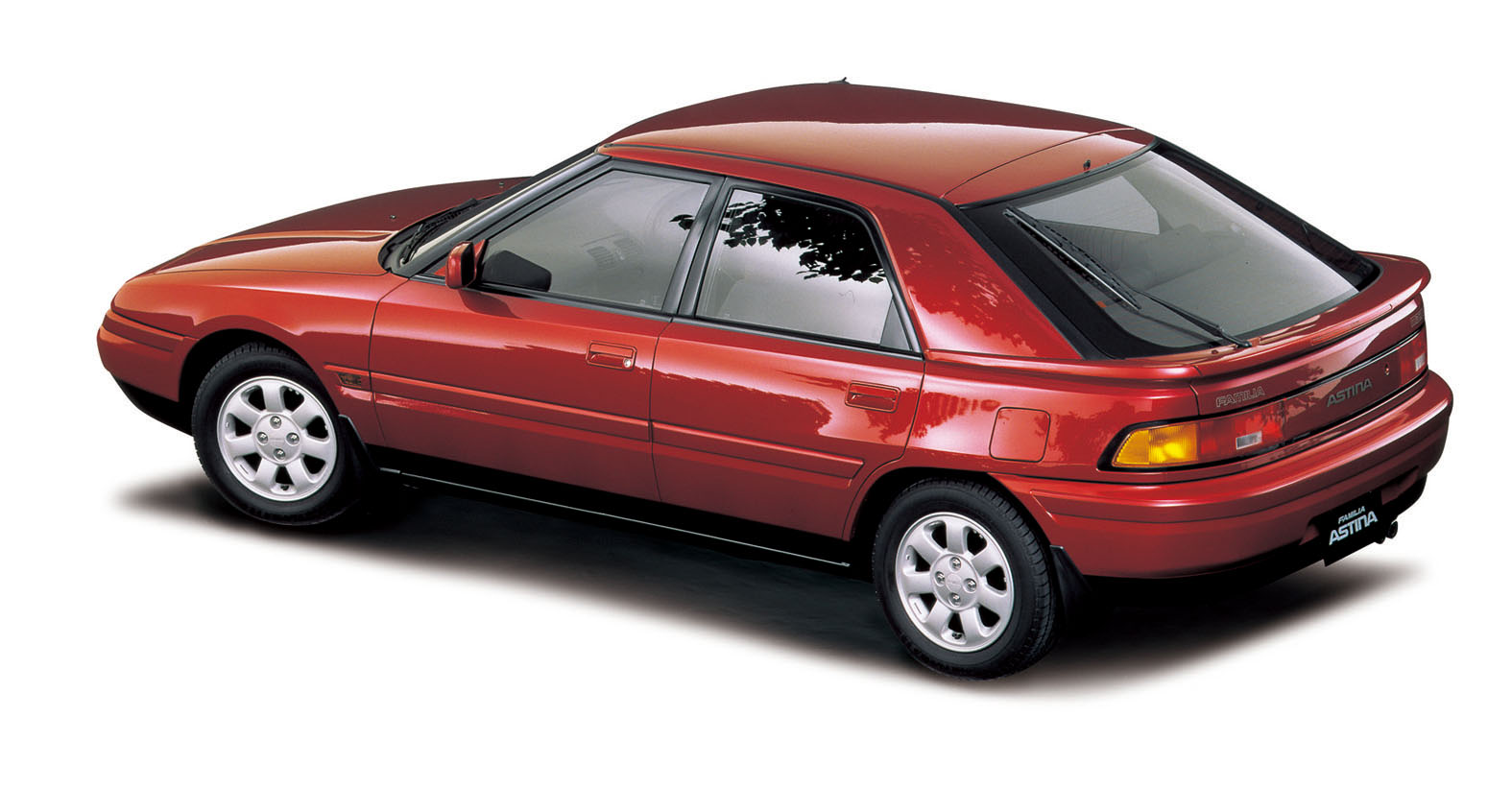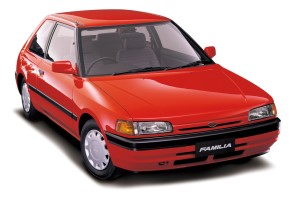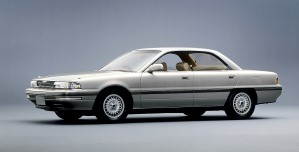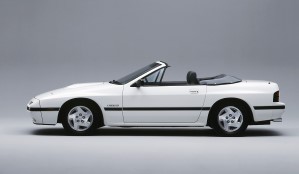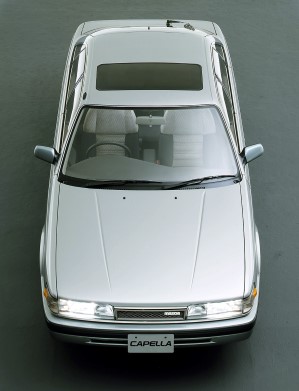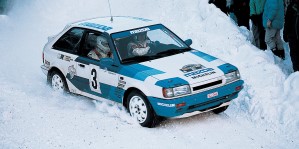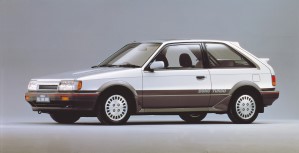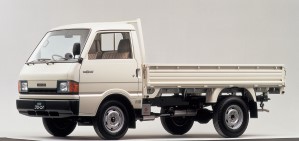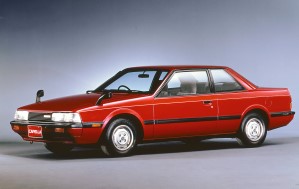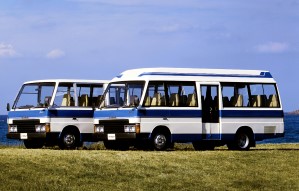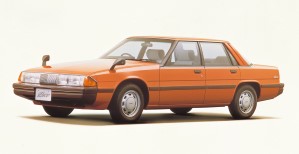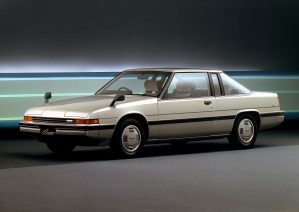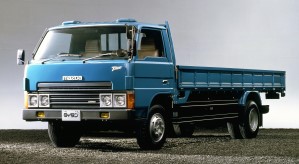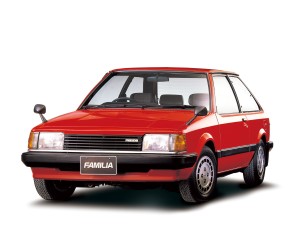History(1980~1989)
1989
| Corporate History | Product History |
11・Hokkaido Kenbuchi Proving Ground is completed |
11・Introduces commercial vehicle, Eunos Cargo(Van, Truck) ・Starts selling Citroen BX19GTi16V at Eunos dealers
·Introduces Eunos 100
The model featured 1800 DOHC and 1500 DOHC engines, an off-black interior and a wing-type rear spoiler.
・Intriduces Eunos 300
The model was available with a 2.0- or 1.8-liter DOHC engine. A sporty appearance was achieved through headlights with integrated fog lights, six in-line round rear taillights and a rear spoiler with a high mount stop lamp. A chic leather interior was also offered.
Front wheel drive was adopted. Suzuki's 547cc, in-line 3-cylinder, 12-valve engine was installed. |
09・Installs high-response driving simulator at research center in Yokohama ・Significantly extends warranty period for new vehicles ・Eunos dealer network starts business from September 1
|
09・Introduces the first-generation Eunos Roadster (MX-5/MX-5 Miata) This was a legitimate sportscar in which driving pleasure was throughly pursued. Following its debut at the Chicago Auto Show, the car received a great response from across the world. In Japan, car-ordering events were held in various locations. With the affordable price of 1.7 million yen, this car became a big hit.
・Starts selling Citroen BX19 at Eunos dealers. |
08・Breaks ground for an engine manufacturing plant of a newly established company in Indonesia, P.T. MAZDA INDONESIA MANUFACTURING(MIM) |
08・Adds full-time 4WD model to 7th-generation Familia (323) (3HB, sedan) lineup
Sports full-time 4WD:To pursue driving pleasure, full-time 4WD with a center differential using a viscous limited slip differential was added. Japan's first unequal torque distribution of 43 : 57 was implemented. 1800 DOHC turbo engine with intercooler output a maximum of 180 horse power. |
07·Begins importing the Citroen BX to Japan |
|
06·Tokyo Branch is renamed Tokyo Head Office ・New dealer network Autozam starts operations |
06・Starts selling Ford Festiva 5 (produced by Kia) at Autorama dealers ・Introduces a small taxi car Customcab ·Starts selling 1st-generation Scrum vans and trucks (Suzuki OEM vehicles) at Autozam dealers |
05・Holds first international Mazda Quality Control Circle in Hiroshima ・Cumulative production of transmissions for Ford reaches 5 million units |
05・Receives an Asahara Young Researcher's award from Society of Automotive Engineers of Japan, Inc. for "Study of exhaust hydrocarbon emission reduction on single-spray direct-injection diesel engine"
・Introduces 4th-generation Titan (T2600/3000/3500/4000)
|
04·Establishes Mazda Eunos and Mazda Autozam dealership channels |
04・Receives the Director-General's award from the Science and Technology Agency (Person of scientific and technological merits) for the development of a new air intake system for the rotary engine
・Introduces 7th-generation Familia Astina (323/323F) The model featured 1600DOHC, 1500 DOHC and 1500 OHC engines and its wedge-shaped body achieved excellent enginerodynamic characteristics. |
02・Displays MX-5 Miata (Eunos Roadster in Japan) at the Chicago Auto Show |
02・Introduces 7th-generation sedan and 3-door hatch back Familia (323)
|
1988
| Corporate History | Product History |
10・Develops internal griding machine T-11J and T-117CNC
·Establishes a sales company in Europe (MME) |
10·Introduces Persona, a 4-door hard top without a center pillar
Unconstrained exterior appearance is coupled with simple, but well-tailored leather or fabric interior.Making a comfortable space was pursued, paying attention to achieving silky-smooth driving and operation feel. |
09・Cumulative production of Capella (626) reaches 3 million units
・Introduces MPV in US. |
09・Provides American network NBC with an EV to cover the marathon at the Seoul Olympic Games
・Updates Luce (929) |
08・Develops a new painting hi-reflex coating technology |
|
06·Starts import of Ford Probe from the US |
06・Introduces the Capella (626) canvas top limited edition |
05·Mazda Innovation (MI) Plan starts
・Reaches production agreement for micro-mini vehicles with Suzuki |
|
02・Adds Capella Cargo (626 Station Wagon) - comes in wagon and van |
1987 |
|
|
Corporate History |
Product History |
12·Mazda reaches an OEM agreement for micro-mini vehicles with Suzuki Motors Co., Ltd.
|
|
11・Develops "13J", a 4-rotor rotary engine for racing. |
|
09・Begins a test run of its energy center at Hiroshima plant ·Mazda begins vehicle production at Mazda Motor Manufacturing USA Corporation(MMUC) |
09・Introduces Capella (626) taxi |
08・Introduces Savanna RX-7 Cabriolet (RX-7 Convertible)
・Adds a 3000cc V6 to the engine lineup for Luce (929) |
|
06・Estabrishes a service center in Beijing ・Opens a new research center in Yokohama, Japan |
|
05・Introduces 5th-generation Capella (626)
Models with a RF2000 diesel engine featuring a pressure wave super charger and a full-time 4WD system were introduced in July. |
|
04・Mazda R&D Center in Ann Arbor is opened ·Cumulative production reaches 20 million vehicles in Japan |
|
03・Cumulative sales of Familia (323) FF in Japan reach 1 million units |
03・Succeeds in developing vehicle speed sensitive 4WS |
02・Familia (323) with full-time 4WD becomes the first Japanese car to win the overall title at Swedish WRC (World Rally Championship).
|
|
01·Introduces Etude This model was a 3-door hatchback with a large glassed area. It came with a 1600 DOHC engine employing a variable air intake system called "VICS". Twin-tube low-pressure gas charged shock absorber and disc brakes on all four wheels helped balance fun driving and a smooth ride. |
1986
| Corporate History | Product History |
12·Mazda R&D Center in Ann Arbor is completed |
|
11·Cumulative production of Familia reaches 5milion units |
|
10・Adds a 2000 LPG engine model of Luce (929) |
|
09・Introduces 5th-generation Luce (929)
|
|
08・Cumulative vehicle exports reach 10 million units |
|
07・Displays cars at Beijing International Automotive Exhibition |
|
06・Cumulative production of vehicles with reciprocating engine reaches 15 million units |
|
05・Moves Osaka office to Minami-ku, Osaka. Newly establishes "Mazda rotary Midosuji" showroom |
|
04·Cumulative production of Mazda rotary-engine vehicles reaches 1.5 million units |
|
03・Cumulative production of diesel vehicles reaches 1.5 million units |
03・Added Familia Cabriolet (323 Convertible-type car)
・3500cc direct injection diesel turbo engine with intercooler was added to Titan for the first time in the class
・Piston with foam nickel was developed |
02·Ford Festiva (Mazda 121) was introduced |
1985
| Corporate History | Product History |
12・Cumulative production of Savanna RX-7 (RX-7) reaches 500,000 units |
12・Introduces all-new Familia wagon (323 Wagon) and Familia van (323 Van)Wagon: 1500 EGI engine was installed Van: drive system was changed from FR (rear-wheel drive) to FF (front-wheel drive). 1500 gasoline, 1300 gasoline and 1700 diesel engines were offered. |
10・Adds full-time four wheel drive to 3-door hatchback of 6th generation Familia (323)
・Introduces 2nd-generation Savanna RX-7 (RX-7) 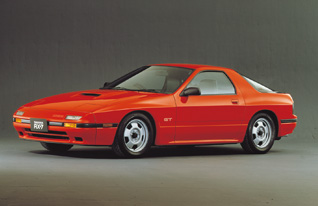 The second-generation, or FC model, Savanna RX-7 was developed as a pure sports car with the perfect balance between driving dynamics and comfort. Its dimensions were 4,310mm (overall length) x 1,690mm (overall width) x 1,270mm (overall height). The FC was powered by the 13B rotary engine (185 horsepower) in a front midship layout, and retained a loyal fan base even after the third-generation model was introduced. |
|
08·Celebrates total cumulative production of 10 million passenger cars |
|
07・Adds Familia(323)diesel engine model |
|
06・Cumulative production of Bongo series (E-series) reaches one million units |
|
05・Newly established a comprehensive performance test course in the Miyoshi Proving Ground |
|
03・Cumulative production of Capella (626) reaches two million units
・Cumulative production of Familia (323) FF reaches two million units |
|
01·Established Mazda Motor manufacturing (USA) Corporation (MMUC) |
01・Introduces 6th-generation Familia (323) |
1984
| Corporate History | Product History |
11·Moriyuki Watanabe becomes chairman and Kenichi Yamamoto becomes president. |
|
10·Establishes Mazda Foundation. |
|
05·Company is renamed as Mazda Motor Corporation. |
|
01・Introduces 3rd-generation Bongo truck (E-Series Truck) This 850 kg truck was available with a 1.4-liter gasoline or 2.0-liter diesel engine and featured a high-tensile steel frame.
・Introduces Bongo Brawny truck (E-Series)
|
1983
| Corporate History | Product History |
10・A wind tunnel testing laboratory for automobiles is completed within the Miyoshi Proving Ground. |
10・Introduces a turbo engine model to Capella (626) sedan and coupe lineup |
09・Makes an investment in Korean automaker Kia. |
09・Adds a Magnum diesel engine model to the Capella (626) sedan lineup ・Adds a new rotary turbo engine model to Savanna RX-7 (RX-7) lineup ・Introduces 3rd-generation Bongo wagon (E-Series) ・Introduces 3rd-generation Bongo van (E-Series) |
07・Cumulative production of Mazda vehicles reaches 15 million units |
|
06・Establishes a company, Mazdaspeed, to offer services in the field of motor-sports |
06·Introduces new Bongo Brawny wagon series (E-series) in Japan The model was available with a 1.8- or 2.0-liter gasoline engine or a 2.0- or 2.2-liter diesel engine. It seated nine or ten people. Ventilated disc brakes were equipped for the front wheels. Some variants offered three rows of full-flat reclining seats. ・Introduces Bongo Brawny van (E-Series) ・Adds turbo engine model to Familia (323/GLC) lineup |
04·Begins local production in Colombia. ・Introduces drilling robots, THMJ-2350AD and THCJ-2350AD |
1982
| Corporate History | Product History |
12・Establishes an auto body company, Mazda Shatai Kanto, within the Chiba distribution center |
12·"Japanese Car of the Year" is awarded to Capella (626) |
10・Adds a two-seater business van model to Familia van (323/GLC Station Wagon) lineup |
|
09·Production begins at Hofu plant (Nishinoura area). |
09・Debuts the world's first rotary turbo engine in the Cosmo (929) and Luce (929)
12A rotary turbo engine: maximum output: 160PS; maximum torque: 23.0kg・m
・Adds a 2.0-liter EGI engine to the engine lineup for Cosmo and Luce Saloons
・Introduces 4th-generation Capella (626) sedan and coupe
|
08・Completes plant for the production of new engines in Ujina west |
|
07・Cumulative production of FF Familia (323/GLC) reaches 1 million units in just 27 months |
|
02・Cumulative production of internal grinding machines reaches 5,000 units, a record in Japan |
|
01・Introduces 2nd-generation Parkway (T2000/3000 bus)
|
1981
| Corporate History | Product History |
12·Start of operations at Hofu Transmission Plant (Nakanoseki area).·Establishes Autorama (begins to supply products from October '82). |
|
10・Cumulative production of FF Familia (323/GLC) complete vehicles reaches 500,000 units in just 18 months |
10・Introduces 4th-generation Luce (929)
This model came in two body types: four-door hardtop with wrap-around rear window and four-door saloon. Five engines were available: a 12A rotary engine with six-port induction, a 2.0-liter MA EGI gasoline engine, a 2.0-liter MA gasoline engine, a 1.8-liter VC gasoline engine and a 2.2-liter diesel engine. The rotary engine variant was introduced in November. |
09・Introduces 2nd-generation Cosmo (929) two-door hardtop (2.0-liter EGI/2.0-liter gasoline engines)
In pursuit of higher aerodynamic performance, wedge-shaped and slanted-nose design were adopted as the basic proportions of this model. Retractable headlights were adopted. The model was developed as high-end specialty car. Four-door hardtop was introduced in October.(2.0-liter EGI/2.0-liter reciprocating engines) Four-door saloon was introduced in October. (2.2-liter diesel, 2.0-liter and 1.8-liter gasoline engines) A model featuring the 12A rotary engine with six-port induction was introduced at the end of November. |
|
07・RX-7 becomes the first Japanese car to win an overall victory at the Total 24 Hours of Spa endurance race Overall victory: car number 40 (Driver: T.Walkinshau / P.Dieudonne) |
|
04·(North America passenger vehicle export regulations adopted).·Cumulative exports reach 5 million vehicles. ·Mazda (North America), Inc. is established. |
1980
| Corporate History | Product History |
12·Familia (GLC/323) receives "1980-1981 Car of the Year Japan". |
|
10・Introduces machining center TMC-H40 and TMC-H60
|
10・Introduces 3rd-generation Titan (T2000/2500/3000/4100 Truck)
The Titan was available with a 2.5-, 3.0- or 4.1-liter diesel engine. Maximum output of the 3.0-liter diesel engine was improved (90PS/3800rpm). Two-way shift (sub-transmission) was installed. Weight was reduced by using high-tensile steel for the traditional box section frame and (truck) box. A comfortable cabin was achieved with reclining seats and multi-use seats. |
08・Opens Harajuku Mazda Rotary showroom in Omotesando, Tokyo |
|
06・Introduces 5th-generation Familia (323)
This model came in two body types: a three-door and five-door hatchback. FF (front-wheel drive) was adopted for this Familia for the first time. The model featured a 1.3-liter E3 or 1.5-liter E5 lean burn engines with EGR and three-way catalysts. Four wheel independent suspension was adopted with strut suspension in the front and SS suspension in the rear. Some models featured full-flat reclining seats, rear lounge seats and rear reclining seats. Four-door sedan Familia Saloon (323 GLC) was added in September 1980. |
|
01·Masaji Iwasawa becomes president. |
